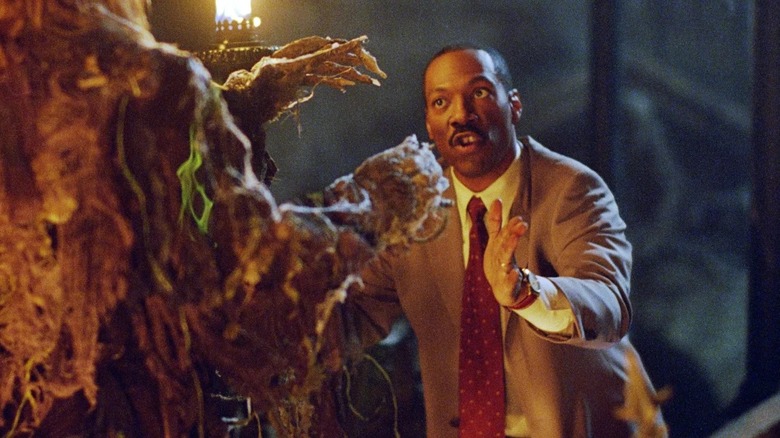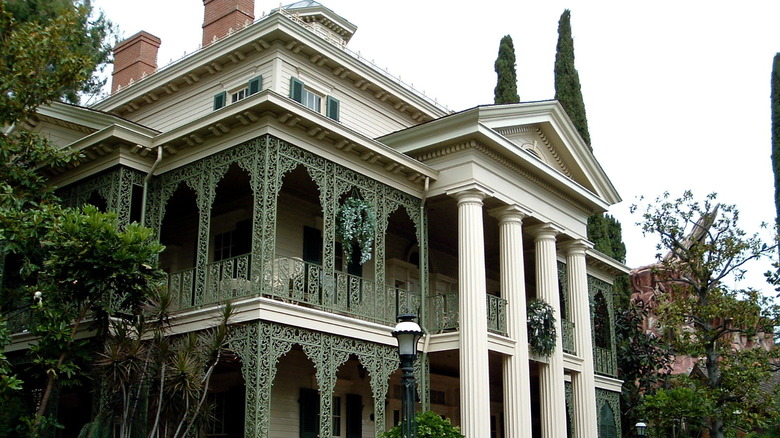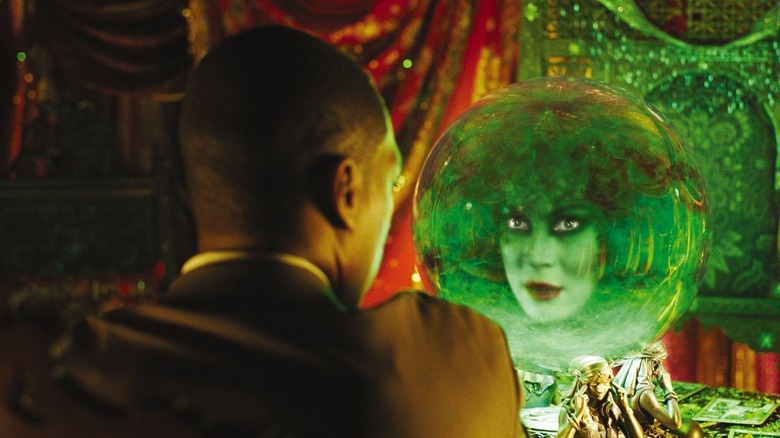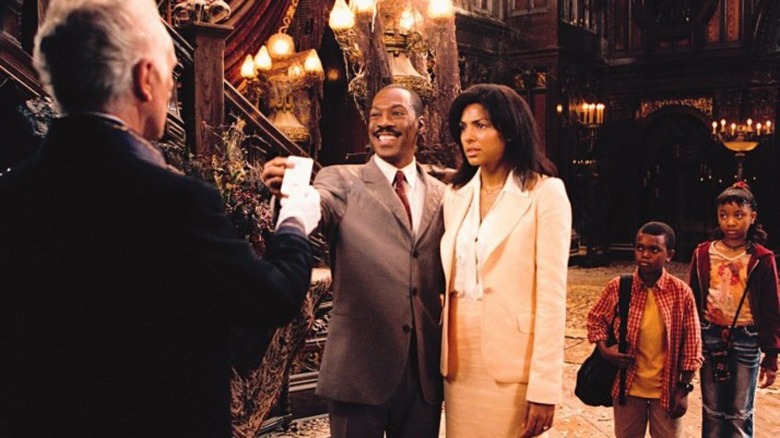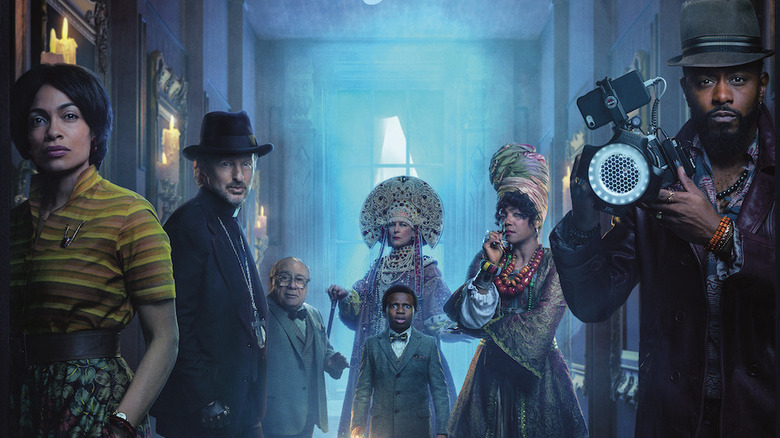Why The Original Haunted Mansion Movie Was A Failure
20 years before Disney's latest attempt at a Haunted Mansion movie, the studio tried and failed to recreate the magic of the theme park ride.
This July, Disney is releasing "Haunted Mansion," an adaptation of one of its most beloved theme park attractions. The company has been trying to get this project off the ground for well over 13 years, with Guillermo del Toro, a Haunted Mansion superfan, at one point attached to direct. Justin Simien of "Dear White People" and "Bad Hair" fame is helming the finished project, and the comedy horror features a starry cast including LaKeith Stanfield, Rosario Dawson, and recent Oscar winner Jamie Lee Curtis. With a reported budget of over $157 million, it's a risky bet for Disney, which has seen a handful of commercial disappointments this year, including "Indiana Jones and the Dial of Destiny." Whether or not general audiences are intrigued by a theme park ride adaptation remains to be seen, but, at the very least, the studio will be hoping it does better than their last attempt at telling this story with Eddie Murphy.
The Haunted Mansion ride is iconic
The Haunted Mansion is a mainstay of Disney's many theme parks, with variations of the attraction to be found in five locations around the world. The original ride, which is the one the two films are inspired by, opened at Disneyland in Anaheim, California, in 1969. It was a rare attempt at horror for Disney, a company that has long prided itself on producing family-friendly entertainment. Initially, Imagineers disagreed on whether the ride should be scary or funny, and eventually settled on something that would be spooky but not off-putting to young kids. The final product is easily one of the most creative and exciting parts of any Disney park visit.
The attraction is a dark ride where visitors enter the grounds and are introduced to the Ghost Host who tells them that they must find a way out of this ghoulish building where 999 happy haunts have made their home. Visitors tour the mansion, see the many ghosts, and whiz through everything as the spirits heartily enjoy their afterlife. While it's not as actively scary as the Twilight Zone Tower of Terror, it's a rare horror feature on Disney property that demonstrates a real affection for the genre. While the effects are a tad wobbly now, the overall experience remains gripping, and the basic message — that we're all going to die and that it might not be so scary as one would think — is about as subversive as the home of Mickey Mouse has ever gotten. It's easy to see why people have long been inspired by the Haunted Mansion, from del Toro to Marvel Comics to ABC's "Once Upon a Time." While there is a narrative here, like all the attractions at Disney parks, the appeal lies in being able to form your own stories throughout. The creative possibilities are endless, and this is a thing that Disney has pioneered and monopolized.
Why theme park movies are unique to Disney
We're well beyond being surprised by non-literary adaptations on the big and small screen. Long gone are the days when the most commonly used material for such things were books and plays. Now, the dominant IPs that fill major studios' slates are comic books, video games, and even toys. Just look at this summer, where the big tentpole releases are "Barbie," "The Flash," and "Gran Turismo," among others. This is the new norm, for better or worse, and Disney is certainly a key player in this new strategy. Just look at the endless slate of Marvel films and series. There is one area, however, where Disney is utterly unique in terms of post-literary IP adaptations: the theme park ride adaptation. It's something that literally only they do, and only they are capable of doing.
Disney's brand is one of worldwide might and wide-reaching nostalgic appeal built across multiple forms. That's primarily rooted in their films, which they savvily re-released over the decades to ensure a new generation of captive audiences, but it can also be found in their theme parks. Not many studios have their own parks, and fewer of them have original attractions that aren't tied into a film or TV series. Before The Haunted Mansion got its film, Disney broke the bank with "Pirates of the Caribbean: The Curse of the Black Pearl," which adapted one of their most historic attractions into an epic historical adventure ghost story. Since then, they've been eagerly trying to recreate this success, from Brad Bird's "Tomorrowland" to "Jungle Cruise," starring Dwayne Johnson. Nothing has come close in terms of critical or commercial gains, and the 2003 "Haunted Mansion" was no exception.
Why the 2003 Haunted Mansion movie failed
2003's "Haunted Mansion" came with an enviable pedigree. Rob Minkoff, one of the co-directors of "The Lion King," helmed the project. The iconic Rick Baker, the multi-Oscar winning make-up designer behind "An American Werewolf in London," helped to create the zombie designs. Eddie Murphy would lead the cast, at a time when he was a major box office star for family films thanks to "Shrek and "Dr. Dolittle" (but less so after "The Adventures of Pluto Nash.") The trailers seemed to nail the ride's mood, albeit with more jokes to appeal to young ones who loved Murphy as Donkey. But the final product fizzled upon arrival, making back double its budget but lambasted by critics for being neither funny nor scary.
The plot of "Haunted Mansion" focuses on Murphy as a workaholic real estate agent who never makes time for his family. When they make their way to the eponymous mansion with plans to help sell it, they fall into the terror of its many ghosts, a blatantly evil butler played by Terrence Stamp, and a murder conspiracy that might involve a reincarnated spirit possibly inhabiting the body of Murphy's wife. The setup is fine, allowing kids and adults alike to be involved in the action. The problem is with the execution, particularly as it relates to Murphy, who never shuts up or stops making bad jokes. It kills the mood instantly, and the gags just aren't funny enough to justify the endless noise. The overall effect it gives is one of Disney simply not wishing to take its own concept seriously. The film is too afraid to be scary and wraps things up with a terrible ending that boils down to "and everyone went to heaven and lived happily ever after." Many who grew up with the film have a nostalgic attachment to it, seeing it as their young introduction to horror in the way many of us latched onto "The Addams Family" or "Hocus Pocus." Yet its cultural footprint remains non-existent outside of theme park devotees and those fascinated by pop culture flops.
Can the new Haunted Mansion avoid repeating past mistakes?
The new "Haunted Mansion" does seem to have fixed one major issue of the first movie: it's actually aiming for scares. The trailer is certainly spooky enough that some parents might worry about taking very young children to see it, and that in and of itself seems nervy for the ever-risk-averse Disney. It's not without humor, and the presence of the likes of DeVito, Owen Wilson, and Tiffany Haddish suggests there will be plenty of jokes throughout.
What proves most encouraging about the marketing is the understanding that the ghosts and their magnificent mansion are alluring to the living for a reason. They are Happy Haunts, after all, and they make the afterlife seem far more fun than what came before it. This is one area where the 2003 film failed abysmally: why would it be a victory for the deliciously devilish ghosts to give up haunting and walk into the light? To water that down is to miss the entire point of the attraction. The Haunted Mansion is Disney acknowledging that there's real fun to be had in rejecting their usual sugary fare for something darker and, dare we say, challenging. If the new movie captures even a sliver of its source material's impishness then it'll be a job well done, but in fairness, Eddie Murphy did set the bar for "Haunted Mansion" success rather low.
